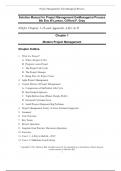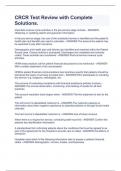MEDCONNOISSEUR Project Management: The Managerial Process Copyright © 2021 McGraw -Hill. All rights reserved. No reproduction or distribution without the prior written c onsent of McGraw -Hill. 2 Chapter Learning Objectives After reading this chapter you should be able to: LO 1 -1 Understand why project management is crucial in today’s world. LO 1 -2 Distinguish a project from routine operations. LO 1 -3 Identify the different stages of a project life cycle. LO 1 -4 Describe how Agile PM is different from traditional PM. LO 1 -5 Understand that managing projects involves balancing the technical and sociocultural dimensions of the project. Review Questions 1. Define a project. What are five characteristics which help differentiate projects from other functions carried out in the daily operations of the organization? A project is a complex, non -routine, one -time effort limited by time, budget, resource, and specifications. Differentiating characteristics of projects from routine, repetitive daily work are below: a. A defined lifespan b. A well -defined objective c. Typically involves people from several disciplines d. A project life cycle e. Specific time, cos t, and performance requirements. 2. What are some of the key environmental forces that have changed the way projects are managed? What has been the effect of these forces on the management of projects? Some environmental forces that have changed the way we manage projects are the product life cycle, knowledge growth, global competition, organization downsizing, technology changes, time -to-market. The impact of these forces is more projects per organization, project teams responsible for implementing proje cts, accountability, changing organization structures, need for rapid completion of projects, linking projects to organization strategy and customers, prioritizing projects to conserve organization resources, alliances w ith external organizations, and so o n. 3. Describe the four phases of the traditional project life cycle. Which phase do you think would be most the difficult one to complete? MEDCONNOISSEUR Project Management: The Managerial Process Copyright © 2021 McGraw -Hill. All rights reserved. No reproduction or distribution without the prior written c onsent of McGraw -Hill. 3 1. Defining: Project specifications objectives are defined, and teams are formed with major responsibilities assigned. Much of this is referred to as defining the Scope of a project. 2. Planning: The creation of a comprehensive plan that in cludes schedules, budgets, staffing an d risk assessment . 3. Executing: Work begin s, deliverables are produced, and progress is monitored. 4. Closing: Putting the project to bed includes customer delivery, post project review or audit, and redeployment of project team . All things being equal, one would think that Closing would be the easiest phase to complete. However, there are times when this phase is the most problematic. Disagreements at the customer acceptance can lead to rework, tension and in many cases litigation. Veteran project managers answer to this question would be ―It all depends‖. 4. What kinds of projects is Agile PM best suited for and why? Projects in which the scope or how the project will be completed are not well defined or stable. These kinds of projects would include software development, R&D work, technolog ical breakthroughs, and creative endeavors. 5. The technical and sociocultural dimensions of project management are two sides to the same coin. Explain. The technical and sociocultural dimensions of project management are two sides of the same coin because successful project managers are skillful in both areas. The point is successful project managers need to be very comfortable and skillful in both areas. Snapshot from Practice : Discussion Questions 1.1 The Project Management Institute 1. If you were a student interested in pursuing a career in project management how important do you think being CAPM would be? There is no data available on the value of the CAPM in the job market. Experts suggest at a minimum it demonstrates a strong interest in project management and a good understanding of the project management processes. Given the growing demand for people to work on projects, the CAPM may just separate you from other applicants. 2. How valuable do you think being a certified PMP is? Reliable data is hard to find. PMI reported that the median salary for a PMP is $108,200. Non-certified project managers, on the other hand, showed a median income of $91,000. Acco rding to a different s urvey , eighty percent of high -performing projects used PMP certified project managers. 1.3 London Calling : Seattle Seahawks versus Oakland Raiders MEDCONNOISSEUR Project Management: The Managerial Process Copyright © 2021 McGraw -Hill. All rights reserved. No reproduction or distribution without the prior written c onsent of McGraw -Hill. 4 1. Why was it important to give players and staff a chance to explore London one evening? This will be a tough question for those not familiar with intense team sports. They will not be aware of the importance coaches devote to eliminating distractions that can disrupt team concentration and focus. Coach Carrol l reportedly said, ― Ther e was no avoiding the fact that we were in a foreign country. Players and staff were curious and excited, so we decided instead of denying it we would let them explore London ‖. 2. What are one or two lessons you learned from this Snapshot? Several lesso ns can be gleaned from this Snapshot: High performance projects need to devote significant attention to providing a work environment that supports high performance. The importance of interjecting fun on intense projects. The impact time zone changes can have on individual performance. The attention to detail exhibited in the project. The importance of managing the rhythm and pace of a group to accomplish project objectives. Sports fans will draw attention to coach Carro ll driving the players to the stadium the day before the game. This eliminated the distraction of not knowing what the field or locker room would be like. It answered the question of what kind of shoes the players would be wearing. Players like quarterback Ru ssell Wilson like to form vivid, mental images of big plays the night before a big game. 1.4 Ron Parker 1. Do you agree with Ron Parker’s statement: ―To be successful, you must also be willing to run at problems/opportunities when everyone else is runnin g away from them‖? This is somewhat of a philosophical question. While not the only way to become successful this is one path to success especially when other opportunities or advantages are not available. Tackling tough projects is a great way to gain visibility and establish a reputation. The flip side is that these projects are risky, and failure may damage one’s reputation. Organizations that excel at project management recognize that these projects often fail despite superior effort. They value experience and devote significant attention to improving future project performance by articulating lessons learned from current projects.MEDCONNOISSEUR





